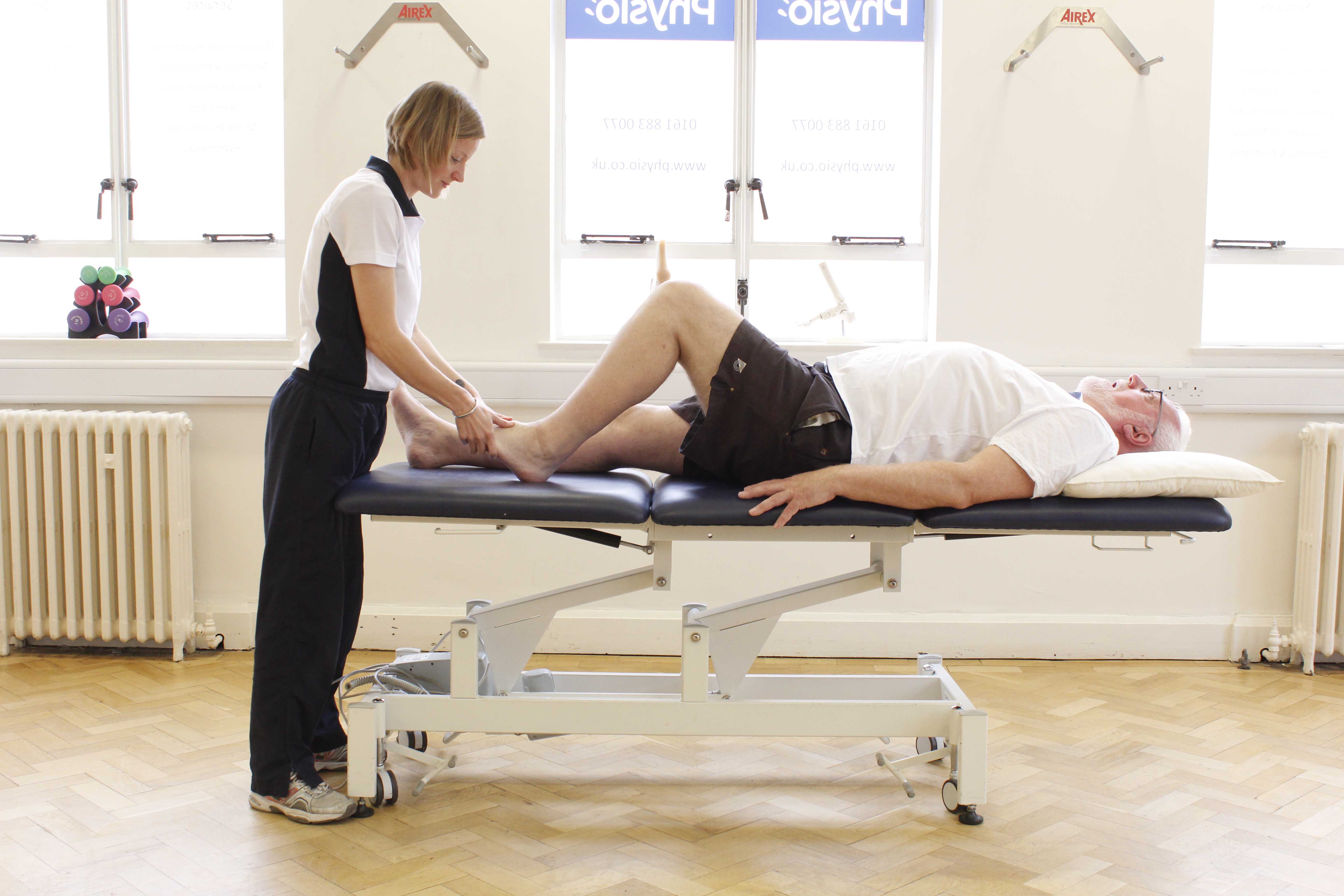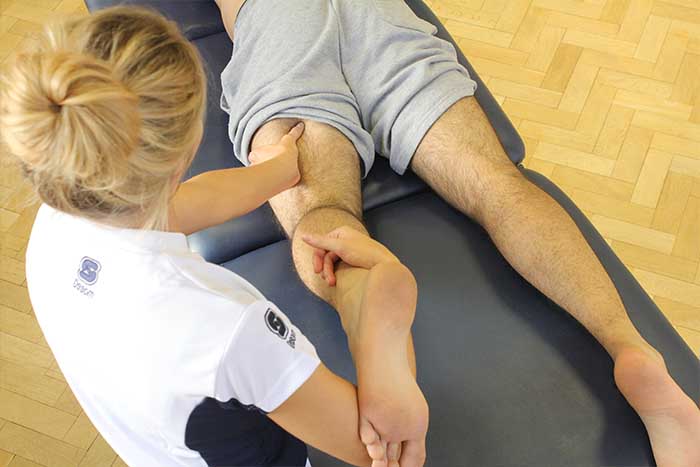Massage therapy can be used to treat and manage a wide range of conditions which are common within the aging population such as tight muscles and arthritis. If tight muscles and arthritis are left untreated it can result in a reduction in range of movement, flexibility, functional performance and the onset of depression. Massage treatment is recommended as it is able to improve an individual's quality of life by offering both physical and psychological benefits.
What is massage for the elderly?
A range of massage techniques that alter in depth, speed, direction and rhythm can be used to treat the elderly and the symptoms they face. The therapists at Physio.co.uk maintain effective communication with their patients to ensure the individual feels comfortable and is receiving both an enjoyable and effective treatment session. Standard massage techniques can be adapted to suit the individual's needs and can address a number of problem areas in just one session.

When can massage help the elderly?
Massage can become part of a management programme for an elderly individual. Multiple massage techniques can be used and tailored to the individual's needs and goals of the service. Throughout the massage, communication between the therapist and patient will remain constant to ensure the patient's tolerance levels are established. Massage therapy can be applied in a number of situations such as;
 Above: Massage and mobilisation of the ankle by a physiotherapist
Above: Massage and mobilisation of the ankle by a physiotherapistMassage therapy can be used when an elderly individual is experiencing chronic pain. Chronic pain refers to pain that has been present for longer than 6 months. The onset of which is sometimes insidious and gradual. If chronic pain is left untreated it can lead to depression, limited range of motion and loss of functioning. Massage strokes using moderate to deep pressure can be applied through a number of specific motions and directions. The application of massage can decrease pain by addressing adhesive scar tissue or muscular tension, assisting in the removal of waste products and increasing tissue temperature.
Massage therapy could also be very beneficial when applied post-injury. When an elderly individual encounters an injury, the healing process is much slower than for an individual at prime age. Massage can be used to promote and assist healing which can speed up the recovery process. Massage can promote healing by improving blood circulation around the injury site which enables macrophages to flood the area and remove dead or damaged cells. Macrophages are cells which can prepare the injury site for healing by recruiting the cells needed for repair such as fibroblasts.
Massage when applied post-surgery can be extremely beneficial with regards to the healing process. Due to the invasive nature of surgery, damage to soft tissue is unavoidable. Upon injury or damage scar tissue is produced. Scar tissue is adhesive and can affect the functioning of surrounding structures such as muscles, tendons, ligaments and fascia. Massage involving moderate to deep strokes can be used to target and breakup the formation of scar tissue, this will enable the tissue structures to regain full functioning much quicker.
Massage therapy be used when an elderly individual is experiencing tight muscles. Tight muscles can cause disruption in gait, posture and overall function. It is important to retain relaxed muscles in order to be fully functioning and pain free. Massage techniques involving moderate pressure strokes can address tightness within muscle fibres by stretching and aligning groups of muscle fibres. Massage can also target tightness within the muscle fascia, a layer of connective tissue surrounding each muscle which, when tight, can restrict functioning and movement.
Massage can be used to target the limited range of movement and pain associated with arthritis via the pain gate theory and an improvement in blood circulation. The pain gate theory states that a non-harmful stimulus such as massage can override messages regarding a painful stimulus on its journey up the spinal pathway. An improvement in blood circulation can increase the temperature of the surrounding tissues and increase the presence of nutrition within the joints which can help improve function with improved range of movement.
What are the physiological effects of a massage for the elderly?
When massage is applied a number of physiological effects occur which enable the individual to encounter benefits following the treatment. The physiological effects of massage include;
-
Increased tissue elasticity
Massage can stimulate vasodilation. Vasodilation refers to the widening of blood vessels. Vasodilation occurs when the smooth muscles surrounding the blood vessels relax, such a process can be observed visually with a pink colouration of the skin. The benefits of increased vasodilation include an increase in tissue temperature, removal of waste products and the deliverance of oxygen and nutrients to the body's tissues.
Massage can increase lymphatic drainage. Lymphatic drainage is achieved through assisting the body's natural lymphatic system which is made up of numerous lymph nodes, lymph glands and lymphatic fluid. The lymphatic system does not have a pump like the heart, therefore the system can become overrun during the presence of excessive swelling, damaged cells or bacteria. Massage strokes can assist in draining excessive lymphatic fluid by pushing the fluid towards lymph nodes where the fluid can be filtered and expelled from the body.
Massage can increase the release of the body's natural endorphins serotonin and dopamine. Endorphins are responsible for regulating mood, appetite and sleep. Low levels of dopamine are linked to lack of enthusiasm and self-doubt. Massage can stimulate an increase in dopamine, which leaves the individual feeling motivated to take actions towards desires goals. Low levels of serotonin are linked to depression and loneliness. Massage can increase levels of serotonin which can result in the feelings of significance and positive thoughts.
Massage can inhibit the release of cortisol a hormone related to stress, anxiety and depression. When a threat is evident the hypothalamus within the brain stimulates the adrenal gland, located on the kidneys to secrete cortisol into the bloodstream. Low levels of cortisol can assist the individual during the "fight" or "flight" response and enable the individual to feel alert and observant. High levels of cortisol can leave the individual feeling depressed, anxious, lonely and negative. Massage can decrease the release of cortisol and reduce feelings of anxiety and depression.
Massage can increase tissue elasticity. Tissue elasticity refers to the tissues ability to elongate under tension. If a tissue holds low elasticity the chance of damage or rupture under tension is increased. Massage can increase tissue elasticity through increasing the temperature of tissues via increased blood circulation which warms the tissues allowing them to relax. Massage can elongate and stretch adhesive collagen fibres allowing them to increase in flexibility and elasticity. An increase in tissue elasticity will improve performance, flexibility and range of movement.

What are the benefits of a massage for the elderly?
Massage therapy can produce a number of benefits for an elderly individual which together can improve quality of life and overall health and wellbeing, such as;
Massage therapy can help increase range of movement by increasing the pliability of the tissues surrounding the joints. The strokes and pressure applied during massage can increase blood circulation, which in turn heats up the area involved. An increase in tissue temperature can improve elasticity, flexibility and joint range of movement. Massage can improve range of movement by decreasing adhesive scar tissue and pain and increasing flexibility.
Massage can increase flexibility by decreasing scar tissue and increasing the tissues temperature. Massage decreases scar tissue by applying deep manipulative strokes which break up adhesive cross-fibre connections. Massage can increase tissue temperature by increasing blood circulation via vasodilation of the surrounding blood vessels. Through decreasing scar tissue and increasing tissue temperature the tissue increases in flexibility, elasticity and range of movement.
Massage can produce a reduction in pain through the pain gate theory and a reduction in muscular tension. The pain gate theory states the messages of pain which are being sent up nerve fibres to the brain can be blocked by messages of massage treatment. The blockage of pain messages to the brain is achieved because messages of massage are sent up an alternative and faster conducting nerve fibre. Muscular tension can result in pain due to the accumulation of waste products, and adhesive collagen fibres. Massage can target muscular tension through deep pressure techniques in order to reduce pain and improve muscular function.
Massage can promote the healing within damaged tissues. Massage therapy can produce a number of physiological effects, one of which is improved blood circulation. The stroking movements during massage can push blood through its blood vessels which in turn creates a vacuum behind causing new blood to flow through. An increase in blood circulation can encourage the exchange of nutrients and waste products between the blood and tissues to occur. The removal of waste products and the deliverance of nutrients are essential in tissue healing.
Massage therapy can reduce feelings of stress. It is common for the elderly population to feel a sense of helplessness and depression due to the onset of a number of condition which may occur due to aging and degeneration. Massage therapy can be used to improve and regulate an individual's mood by altering the release of hormones. Massage can inhibit the body's production of stress hormones such as cortisol while stimulating the production of serotonin and dopamine, which are endorphins linked to positive emotions and a sense of well-being.
Summary
Overall, massage treatment can be extremely beneficial to the elderly and should be implemented regularly to ease the symptoms associated with aging. Massage treatment can be extremely beneficial when applied during situations such as chronic pain, post-injury, tight muscles and arthritis. The benefits of applying massage include increased range of movement, flexibility and healing and decreased pain and stress. The benefits of massage for the elderly are achieved through a number of physiological effects such as increased tissue temperature, vasodilation, lymphatic drainage, endorphins release and tissue elasticity. In addition to a reduction in the release of cortisol.
How can I arrange a massage for the elderly?
To arrange a massage to help the elderly at Physio.co.uk, email us at office@physio.co.uk or call us on 0161 883 0077.
You can also book an appointment online and save £10.

 0330 088 7800
0330 088 7800



































